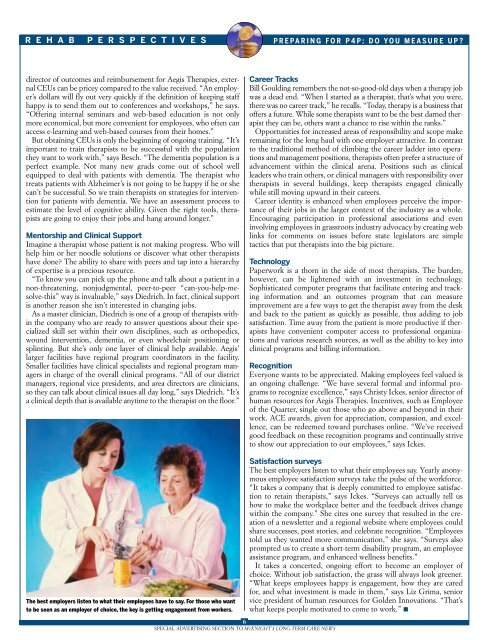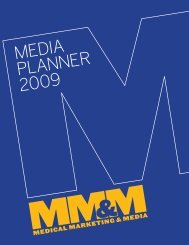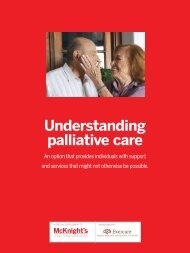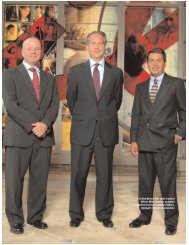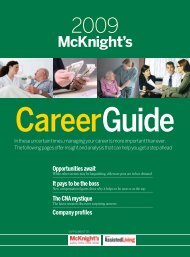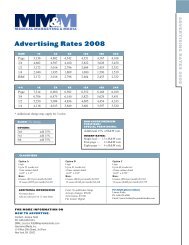RehabPerspectivesApril 2008 - Haymarket Media Group
RehabPerspectivesApril 2008 - Haymarket Media Group
RehabPerspectivesApril 2008 - Haymarket Media Group
Create successful ePaper yourself
Turn your PDF publications into a flip-book with our unique Google optimized e-Paper software.
R E H A B P E R S P E C T I V E S PREPARING FOR P4P: DO YOU MEASURE UP?<br />
director of outcomes and reimbursement for Aegis Therapies, external<br />
CEUs can be pricey compared to the value received. “An employer’s<br />
dollars will fly out very quickly if the definition of keeping staff<br />
happy is to send them out to conferences and workshops,” he says.<br />
“Offering internal seminars and web-based education is not only<br />
more economical, but more convenient for employees, who often can<br />
access e-learning and web-based courses from their homes.”<br />
But obtaining CEUs is only the beginning of ongoing training. “It’s<br />
important to train therapists to be successful with the population<br />
they want to work with,” says Besch. “The dementia population is a<br />
perfect example. Not many new grads come out of school well<br />
equipped to deal with patients with dementia. The therapist who<br />
treats patients with Alzheimer’s is not going to be happy if he or she<br />
can’t be successful. So we train therapists on strategies for intervention<br />
for patients with dementia. We have an assessment process to<br />
estimate the level of cognitive ability. Given the right tools, therapists<br />
are going to enjoy their jobs and hang around longer.”<br />
Mentorship and Clinical Support<br />
Imagine a therapist whose patient is not making progress. Who will<br />
help him or her noodle solutions or discover what other therapists<br />
have done? The ability to share with peers and tap into a hierarchy<br />
of expertise is a precious resource.<br />
“To know you can pick up the phone and talk about a patient in a<br />
non-threatening, nonjudgmental, peer-to-peer “can-you-help-mesolve-this”<br />
way is invaluable,” says Diedrich. In fact, clinical support<br />
is another reason she isn’t interested in changing jobs.<br />
As a master clinician, Diedrich is one of a group of therapists within<br />
the company who are ready to answer questions about their specialized<br />
skill set within their own disciplines, such as orthopedics,<br />
wound intervention, dementia, or even wheelchair positioning or<br />
splinting. But she’s only one layer of clinical help available. Aegis’<br />
larger facilities have regional program coordinators in the facility.<br />
Smaller facilities have clinical specialists and regional program managers<br />
in charge of the overall clinical programs. “All of our district<br />
managers, regional vice presidents, and area directors are clinicians,<br />
so they can talk about clinical issues all day long,” says Diedrich. “It’s<br />
a clinical depth that is available anytime to the therapist on the floor.”<br />
The best employers listen to what their employees have to say. For those who want<br />
to be seen as an employer of choice, the key is getting engagement from workers.<br />
6<br />
SPECIAL ADVERTISING SECTION TO MCKNIGHT’S LONG-TERM CARE NEWS<br />
Career Tracks<br />
Bill Goulding remembers the not-so-good-old days when a therapy job<br />
was a dead end. “When I started as a therapist, that’s what you were,<br />
there was no career track,” he recalls. “Today, therapy is a business that<br />
offers a future. While some therapists want to be the best darned therapist<br />
they can be, others want a chance to rise within the ranks.”<br />
Opportunities for increased areas of responsibility and scope make<br />
remaining for the long haul with one employer attractive. In contrast<br />
to the traditional method of climbing the career ladder into operations<br />
and management positions, therapists often prefer a structure of<br />
advancement within the clinical arena. Positions such as clinical<br />
leaders who train others, or clinical managers with responsibility over<br />
therapists in several buildings, keep therapists engaged clinically<br />
while still moving upward in their careers.<br />
Career identity is enhanced when employees perceive the importance<br />
of their jobs in the larger context of the industry as a whole.<br />
Encouraging participation in professional associations and even<br />
involving employees in grassroots industry advocacy by creating web<br />
links for comments on issues before state legislators are simple<br />
tactics that put therapists into the big picture.<br />
Technology<br />
Paperwork is a thorn in the side of most therapists. The burden,<br />
however, can be lightened with an investment in technology.<br />
Sophisticated computer programs that facilitate entering and tracking<br />
information and an outcomes program that can measure<br />
improvement are a few ways to get the therapist away from the desk<br />
and back to the patient as quickly as possible, thus adding to job<br />
satisfaction. Time away from the patient is more productive if therapists<br />
have convenient computer access to professional organizations<br />
and various research sources, as well as the ability to key into<br />
clinical programs and billing information.<br />
Recognition<br />
Everyone wants to be appreciated. Making employees feel valued is<br />
an ongoing challenge. “We have several formal and informal programs<br />
to recognize excellence,” says Christy Ickes, senior director of<br />
human resources for Aegis Therapies. Incentives, such as Employee<br />
of the Quarter, single out those who go above and beyond in their<br />
work. ACE awards, given for appreciation, compassion, and excellence,<br />
can be redeemed toward purchases online. “We’ve received<br />
good feedback on these recognition programs and continually strive<br />
to show our appreciation to our employees,” says Ickes.<br />
Satisfaction surveys<br />
The best employers listen to what their employees say. Yearly anonymous<br />
employee satisfaction surveys take the pulse of the workforce.<br />
“It takes a company that is deeply committed to employee satisfaction<br />
to retain therapists,” says Ickes. “Surveys can actually tell us<br />
how to make the workplace better and the feedback drives change<br />
within the company.” She cites one survey that resulted in the creation<br />
of a newsletter and a regional website where employees could<br />
share successes, post stories, and celebrate recognition. “Employees<br />
told us they wanted more communication,” she says. “Surveys also<br />
prompted us to create a short-term disability program, an employee<br />
assistance program, and enhanced wellness benefits.”<br />
It takes a concerted, ongoing effort to become an employer of<br />
choice. Without job satisfaction, the grass will always look greener.<br />
“What keeps employees happy is engagement, how they are cared<br />
for, and what investment is made in them,” says Liz Grima, senior<br />
vice president of human resources for Golden Innovations. “That’s<br />
what keeps people motivated to come to work.” ■


